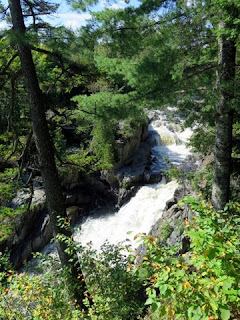3rd return trip to Appalache hills south of Plessisville
Yesterday was my third-week-in-a-row ride in the Appalachian hills south of Plessisville in a region called Les Appalaches and also L'Erable (maple) region.
I took the easiest route into the hills via highway Rt 267. Going against my preference of quiet roads, this is the easiest road into the hills from the ride start in Plessisville which is in the flattish St-Laurence-valley lowlands.
In Inverness I took a look at some of the many road-side bronze sculptures, which Inverness has because it is Quebec;s bronze sculpture capital. There are several bronze factories, exhibition spaces, and also the delightful Museum of Bronze. It's a national treasure.
From Inverness is is only 20 minutes on Chemin Gosford until the very nice parc de Chutes de Lysander falls. Usually on this ride this is my first sit-down rest stop, but today I kept going another 20 minutes on the same road to the Pont Rouge covered bridge. There is a big regional parc around this river (rivière Palmer) just after the bridge.
Then is over to Leeds, and onto Chemin Craig. Ride up nd over and past Kinnear's Mills and up to the hilltop belvedere Google calls l'Observatiore Craig. Craig Road is one of my top ten bike roads in all of Quebec. From this lookout you can see Quebec city. Mont Ste-Anne and the first of the capes (Caps) of the Charlevoix, Cap Tourement.
From this hilltop highlight-of-the-ride, it is only 100 metrers until another highlight: Carig road continues with a straight-down-the-hill descent at 17%. Woohoo speed is reached immediately. Then is is 13 zoomy minutes until the stop sign in St-Jean-de-Brebeuf. There is a well-hidden road-side cemetery dating from the early 1800s english colonization days with a sign called "Chapel" although there is no chapel. It is a nice quiet secluded rest stop location. it is very park-like and has lots of open space once you know where it is.
I continued and bought a big bottle of water in St-Jean-de-Brebeuf. For free water, there is also a natural spring at the side of the road about a kilometre further west on Chemin Craig.
The next section is another favorite section, over a big hill and down down down to Irlande and then Maple Grove. Turn left at the T and you start the climb to St-Julien. Second highest town in Quebec! Right at the bottom is an historic church, take the church's second (uphill) entrance and find the picnic table under the giant oak tree. It's a perfect rest stop.
Look around in St-Julien, there are great views (and benches and/or parks) in EVERY direction. Now go back down the road you came up, woohoo!
You can do a quick allez-retour to Vianney for a second hilltop town (easier and shorter than St-Julien with a better road).
Finally the rang St-Sophie is the backroad north to Ste-Sophie d'Halifax and then flats to Plessisville. This is one last ultimate back road to enjoy, with a nice hill to cross before the descent into and through Ste-Sophie.
And that's the ride.
And I love it.























































